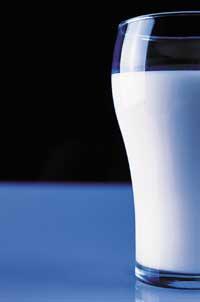Ancient cheese Idiazabal
2003/02/01 Andonegi Beristain, Garazi - Elhuyar Zientziaren Komunikazioa Iturria: Elhuyar aldizkaria
Rennet is an indispensable ingredient for making cheese. But lately I was about to lose the traditional rennet used for centuries. In fact, in many of the cheeses of the denomination of origin Idiazabal is used commercial rennet instead of traditional.
To get the traditional rennet it is necessary to kill a lamb of approximately a month. The lamb dies when he just drinks milk and is removed from his fourth stomach, which is filled with milk. This stomach is dried, mixed with salt, and a paste is formed. The shepherds kept this pasta and when they were going to make the cheese, mixing it with water, the rennet was obtained.
In the case of the commercial cuajo, the process of obtaining pasta is the same. From this mass the rennet is obtained through the filtration of water and is sold in liquid form or in powder. These liquids or powders, however, do not have the characteristics of the traditional rennet.

The shepherds suspected that with traditional rennet they obtained better cheeses. However, the traditional rennet had a problem: not always the same cheeses were obtained. Seven years ago, they contacted the UPV researchers to know why these changes were produced.
The secret is in the lipases
The researchers first studied the traditional saleros of the shepherds. After analyzing the strength and composition of the coagulation of them, similar cuajas were produced in the laboratory. With these boxes, cheeses, and their taste, odors, etc. Once analyzed, its relationship with the pasta used was established. In these studies, the importance of lipase was discovered.
Lipase is a very special enzyme that when the lamb takes milk flows under the tongue. This enzyme, together with milk, reaches the stomach, which is the one used to make the garlic paste.
The majority of the masses, therefore, contain lipases. But in the salineros that are sold in the form of liquid or dust the lipases are lost. Not only that, the traditional rennet used by the shepherds, the liquid, if preserved for a long time, also loses lipases. That is why different cheeses come out, since the amount of lipase defines the strength of the cheese.
In view of this, the researchers sought to control the quantity of cuajo lipase and began to industrially produce the mass of the traditional cuajo. This mass will be marketed by a Vallisoletan company that, in view of the interest and good behavior shown by the shepherds, hopes to recover the traditional product. In addition to Idiazabal cheese producers, other pastors from other communities have already shown their interest in trying this traditional dough.
The researchers highlighted that their good relationship with pastors has contributed significantly to the results of the research, and have shown their willingness to carry out more research that may be useful to pastors in the future.
- Title of projectCharacterization of sheep hides and optimization of manufacturing methods to recover the traditional flavors of sheep and goat cheese.
- Biochemical and technological characterization of the cuajo paste obtained from the Objective and standardization of the manufacturing process.
- Project DirectorMertxe de Renobales Scheifler.
- UPV Template: M. de Renobales, M. Virto, L.J. Rodríguez, F.J. Perez-Elortondo, M. Albisu, A. Nájera.University of Murcia: Mª B. López, J. Laencina, Mª D. Garrido, S. J. Bañón, J. M. M. Ros, E. Ferrandini. Caporal Cuajos: A. A. Guerra, C. Slim.
- | Biochemistry and Molecular Biology, Food Technology, Nutrition and Bromatology
- Faculty of Pharmacy of Vitoria-Gasteiz

Gai honi buruzko eduki gehiago
Elhuyarrek garatutako teknologia





